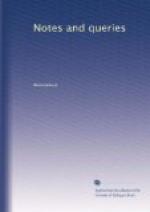This variation of legends favours the idea that the cultus of Blasius was founded upon that of some deity worshipped in Cappadocia, whose rites and attributes may have varied in different localities.
C.W.G.
Sangred—Judas Bell.—“BURIENSIS” inquires (p. 124.) what sangred is. This term is noticed in Rock’s Church of Our Fathers, t. ii. p. 372. In the very interesting, “Extracts from Church-warden’s Accounts,” p. 195., it is asked what “Judas’ bell” was. I presume it to have been a bell named after, because blessed in honour of the apostle St. Jude, who, in the Greek Testament, in the Vulgate, and our own early English translations, as well as old calendars, is always called Judas, and not Jude, as a difference from Judas Iscariot.
CEPHAS.
La Mer des Histoires.—“MR. SANSOM” (No. 18. p. 286.) has inquired, What is known of Columna’s book, entitled Mare Historiarum? Trithemius has made mention of the work (De Script. Eccles. DL.), and two manuscript copies of it are preserved in the Royal Library at Paris. (B. de Montfaucon, Biblioth. Bibliothecar. MSS. tom ii. p. 751. Par. 1739.) Douce very properly distinguished it from La Mer des Histoires; but, if he wrote “Mochartus,” he was in error; for Brochart was the author of the Latin original, called Rudimentum Novitiorum, and published in 1475. As to the statement of Genebrard, that Joannes de Columna was the writer of the “Mater Historiarum,” I should say that the mistake was produced by confounding the words Mer and Mere. Mr. Sansom may find all the information {326} that need be desired on this subject in Quetif et Echard, Scriptores Ord. Praed. tom. i. pp. 418-20. Lut. Paris, 1719. (Vid. etiam Amb. de Altamura, Biblioth. Dominican. p. 45. Romae, 1677; Fabricii, Bibl. Med. et Inf. Latin. i. 1133. Hamb. 1734.)
R.G.
“What are depenings?” (No. 18. p. 277.)
The nets used by the Yarmouth herring busses were made in breadths of six feet. The necessary depth was obtained by sewing together successive breadths, and each breadth was therefore called a deepening.[4]
ED.
[Footnote 4: From a pamphlet written about 1615, not now before us. ED.]
* * * * *
MISCELLANIES.
Tale of a Tub.—It is generally supposed that the title of Swift’s Tale of a Tub was a jest originally levelled at the Puritan pulpit. It probably had served a more ancient purpose. In Bale’s Comedye concerning Three Laws, compiled in 1538, Infidelitas says:
“Ye say they follow
your law,
And vary not a shaw,
Which is a tale
of a tub.”
J.O.W.H.
* * * * *




